From U.S. Fish and Wildlife Service, Mountain-Prairie Region:
'16 Bear River Photo contest - Clark's Grebe swimming in the water with a chick on its back.
Credit: Sondra Dexter / USFWS
#USFWS
Protecting natural resources, including air, land and water. Also of interest are threatened and endangered species as well as endangered species. Conservation (wildlife, soil, water, etc.) issues also discussed. Topics include: RCRA, CERCLA, Clean Water Act (CWA), NEPA, 404 Permits, EPCRA, FIFRA, and others.
Search This Blog
Wednesday, November 30, 2016
White-crowned Sparrow
From U.S. Fish and Wildlife Service Midwest Region:
Much like our regional accents, white-crowned sparrows have their own dialect. Males on the border of other dialects can be bilingual, singing both songs!
Photo: White-crowned sparrow by Bill Thompson/USFWS.
#Bird
Much like our regional accents, white-crowned sparrows have their own dialect. Males on the border of other dialects can be bilingual, singing both songs!
Photo: White-crowned sparrow by Bill Thompson/USFWS.
#Bird
Wily coyotes continue to thrive in the Southeast at the expense of deer populations
From the #USDA:
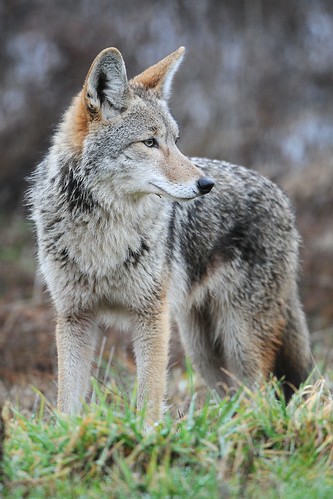
Posted by Diane Banegas and Zoë Hoyle, U.S. Forest Service, Research and Development, on November 22, 2016 at 11:58 AM

Historically a species of the North American plains, coyotes now occupy much of the Southeast. (Photo by Rebecca Richardson, courtesy of Wikimedia.org.)
Coyotes began migrating eastward throughout the latter half of the 20th Century. Once restricted to the western plains, they now occupy most of the continent and have invaded farms and cities, where they have expanded their diet to include squirrels, household pets and discarded fast food.
Land-use changes in the U.S., the disappearance of wolves, a growing human population, and a remarkable ability to adapt to new environments and conditions encouraged coyotes to expand into new habitats and thrive, while other predators faced with similar pressures dwindled and faced extinction.
John Kilgo, a research wildlife biologist with the U.S. Forest Service, said humans transporting coyotes to the Southeast as hunting stock also sped up coyote establishment in that region. Some escaped into the wild, survived and reproduced. The purpose of Kilgo’s research is to better understand the abundance, population dynamics, and ecology of coyotes in the Southeast, as well as the magnitude of coyote predation on deer fawns and the potential for this predation to affect deer population size.
“Bottom line, the coyote is here to stay in the Southeast,” Kilgo said. “Before they migrated into the Southeast, hunting was barely able to keep up with expanding deer populations.” Coyotes rarely attack adult deer, but they prey on fawns.
“Trapping is probably too time consuming and labor intensive for private landowners to adopt, especially when the results are uncertain,” Kilgo said. “The best way to ensure that more fawns survive is to shoot fewer does during hunting season because that means more fawns will be born in the spring.”
Deer hunting is a very popular activity in South Carolina, generating about $200 million in direct retail sales annually. The 2015 Deer Hunter Survey documents a decline in the state’s deer population since the 1990s that coincides with the increase in coyotes. The report also noted Kilgo’s research at the U.S. Department of Energy’s Savannah River Site. Findings from the study, along with declines in deer numbers, prompted the state of South Carolina to implement stricter bag limits for deer as a result of the documented reductions in fawn recruitment.
Only time will tell if the stricter rules on deer hunting are effective in reducing their downward population trend. One factor could be whether the now-established coyote population continues to swell in South Carolina and elsewhere in the South. They are highly adaptable to new conditions and appear to be thriving in the South. Coyotes eat almost anything, vegetation as well as meat. They eat everything from roadkill to rabbits to wild fruits.
Given their fecundity and adaptability, do coyotes have a natural nemesis?
“When it comes to canines such as wolves, coyotes or foxes, the big dog wins,” Kilgo said. Their numbers declined in Yellowstone National Park after the wolves were re-introduced there. With no current plans to bring wolves to the Southeast, Kilgo said wildlife managers need to accept coyotes as a permanent presence and researchers need to get a better understanding of their effects on other species and the ecology of the region.
Related Posts
Artisan Cheese Makers Embrace Voluntary Conservation at Award-Winning Vermont Dairy
From the #USDA:

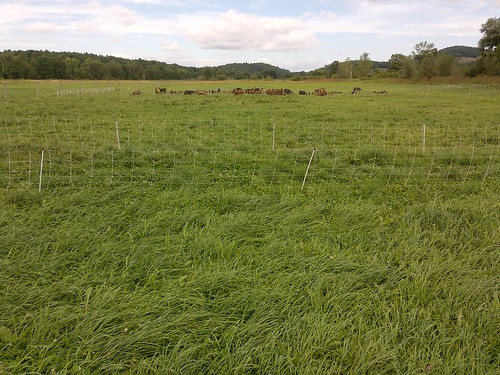
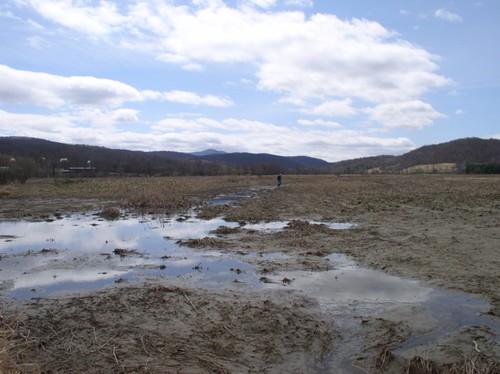
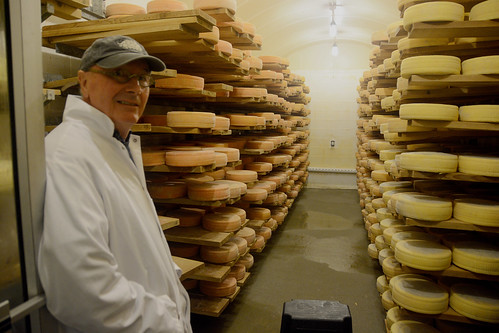
Posted by Amy Overstreet, USDA NRCS Vermont, on November 18, 2016 at 10:23 AM

Cheesemakers left to right: Creamery Manager and Head Cheesemaker Leslie Goff (center) with Consider Bardwell owner Angela Miller (right) and cheesemaker Anastasia Barrett. Photo: Amy Overstreet, NRCS Vermont.
The story behind Vermont’s Consider Bardwell could be the plot for a great movie. The lead characters are Russell and Angela, two New York City executives who decide in their fifties that they want to buy a farm, raise goats, and be artisan cheesemakers. The setting is a 300-acre dairy farm and cheese operation in West Pawlet, Vermont. And the twist…they had no previous farming experience.
What could have been a comedy is an inspiring story of dedication and perseverance. This is the true tale of an architect and a literary agent who pursue a dream to farm sustainably through a voluntary conservation approach, and create a unique farm-to-plate product. Their partnership with USDA’s Natural Resources Conservation Service (NRCS) is helping to ensure the health of the natural resources on their farm.
When the couple visited friends in Dorset, Vermont, in 2000, they were inspired to search for their own farmstead, and discovered a beautiful property straddling Vermont and their home state of New York. A short year later, they connected with local NRCS Soil Conservationist Sally Eugair to improve the farm through conservation supported by Farm Bill programs.

With technical and financial assistance from USDA-NRCS, 195-acres of cornfields were planted to grass to provide a healthy and sustainable forage source for the health of the goats which provide milk for the cheese. Photo: Amy Overstreet, NRCS Vermont.
Russell and Angela started from scratch when they made the decision to revive the farm, and embarked on a quest to teach themselves everything they could about the land management and cheesemaking.

With technical and financial assistance from USDA-NRCS, 195-acres of cornfields were planted to grass to provide a healthy and sustainable forage source for the health of the goats which provide milk for the cheese. Photo: Amy Overstreet, NRCS Vermont.
Eugair helped enroll them in the Agricultural Conservation Easement Program (ACEP) which allowed them to permanently protect 195-acres of healthy grazing lands for their herd of Oberhasli goats. Then, they converted all the continuously cropped cornfields to lush, healthy grasslands—providing a healthy and sustainable forage source for their goats and protecting nearby water quality.
“The grasslands also provide a valuable nesting and breeding area for many bird species,” explained Eugair.
The Environmental Quality Incentives Program (EQIP) plan included well-managed grazing systems that improve the health and vigor of plants, enhance water quality, and reduce soil erosion. Their prescribed grazing plan allows the grass to recover while paddocks are resting and encourages the animals to uniformly graze.
Last year, they made more than 97,000 pounds of cheese from the milk of 150 goats and 65 cows without pesticides or fertilizers. And, their cheeses have been winning national and international awards for the past ten years—and their product is served in some of the nation’s finest restaurants. Today, they have a full-time staff of 20, including three cheesemakers who produce small batches of cheese from unpasteurized milk that is antibiotic and hormone free.

Russell’s skills as an architect were useful in the design of Consider Bardwell’s special caves where cheese is aged to perfection. Photo: Amy Overstreet, NRCS Vermont.
When asked about the future of the business, Angela and Russell hope to expand. “We are not the kind to retire,” they explain. Both still maintain their full-time jobs as an architect and a literary agent. Russell says he believes part of their success is due to their ‘vertically integrated business’ approach. “We raise the animals, make the cheese with milk that we produce, and personally take our product all the way to the consumers.” They believe this is important to their customers who are more aware of how their food is produced. And, their dedication to voluntary conservation is ensuring that the natural resources at Consider Bardwell will be healthy and vibrant for generations to come.
Related Posts
Sagebrush Songbirds under the Sage Grouse Umbrella
From the #USDA:
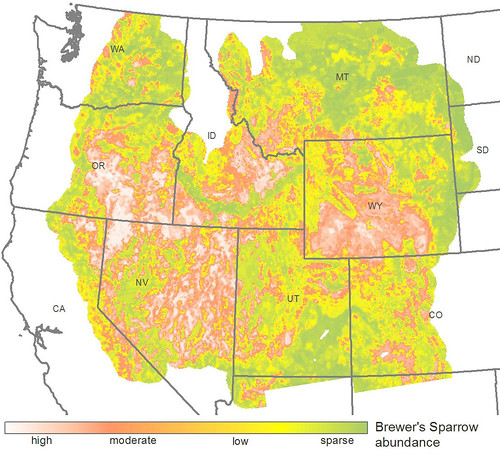
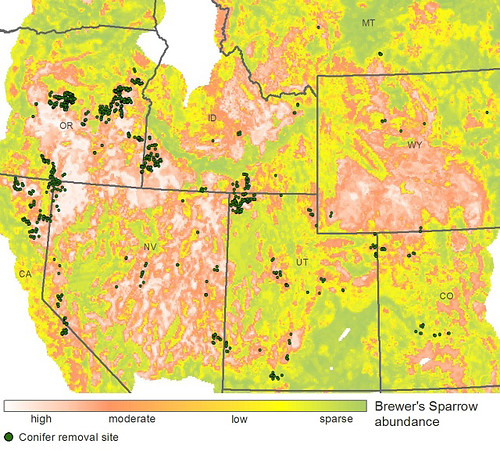
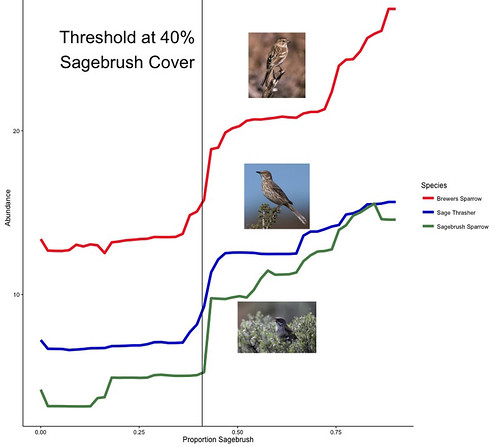
Posted by Thad Heater, Sage Grouse Initiative Coordinator, Natural Resources Conservation Service, on November 18, 2016 at 8:59 AM

New maps reveal the patterns of abundance of sagebrush songbirds, based on Breeding Bird Survey count data combined with sagebrush cover, landform, and climate variables. Shown here is the range-wide relative abundance of Brewer’s sparrow. Map courtesy Patrick Donnelly, IWJV.
The charismatic sage grouse is often in the spotlight as the flagship species in the sagebrush ecosystem. The smaller songbirds that live alongside the grouse don’t always attract as much attention, but they are also good indicators of how the sagebrush range is faring.
Recently, in a project funded by the Sage Grouse Initiative (SGI), the U.S. Fish and Wildlife Service (FWS) and Intermountain West Joint Venture (IMJV), scientists set out to evaluate whether investments in sage grouse conservation serve as an “umbrella” that extends benefits to other sagebrush-dependent wildlife, too. These findings are summarized in a new Science to Solutions report by SGI, a partnership led by USDA’s Natural Resources Conservation Service (NRCS).
We know from past SGI-funded research that easements put in place for sage grouse also doubled the protection of mule deer migration habitat and winter range, and that removing encroaching juniper to restore sage grouse habitat in Oregon increased the abundance of two sagebrush-loving songbirds by 50 to 80 percent.
Researchers Patrick Donnelly with IMJV and Jason Tack with University of Montana’s Avian Science Center used a trio of songbirds to further gauge the reach of the sage grouse umbrella across the West: the Brewer’s sparrow, sagebrush sparrow and sage thrasher. All three species have suffered from population declines due to the widespread loss and degradation of sagebrush habitats, and are identified as species of conservation concern by the FWS.

This map shows that high Brewer’s sparrow abundance overlaps with high-elevation conifer removal projects. Map courtesy Patrick Donnelly, IWJV.
First, these researchers created abundance maps for each of the sagebrush songbirds using long-term bird count data coupled with measures of climate and habitat conditions. They found that the abundance of each songbird doubled when sagebrush covered 40 percent or more of the landscape. Unfortunately, they also discovered that fewer than 25 percent of sampled sites exceeded the 40 percent threshold of sagebrush-rich habitat.
Second, the scientists compared patterns of songbird abundance with the distribution of sage grouse leks, or mating grounds. Near large leks, which support 50 percent of known grouse populations, abundance was 15 percent higher for Brewer’s sparrow, 13 percent for sagebrush sparrow, and 19 percent for sage thrasher.
Third, they examined how sagebrush songbirds may benefit from sage grouse conservation actions taking place in 11 western states. Tack and Donnelly found that targeted conservation efforts for sage grouse also provide significant conservation benefits for these songbird species.
For instance, in the Great Basin, the maps revealed that 85 percent of conifer removal projects to restore sagebrush habitat overlapped with high abundance centers for Brewer’s sparrow. In drier reaches of sage grouse range, the scientists found that priority areas for managing weed invasions and wildfire (identified by the Bureau of Land Management and U.S. Forest Service) encompassed 51 percent of estimated sagebrush sparrow abundance and 55 percent of sage thrasher abundance.
In addition, the research showed that Wyoming’s land protection strategy for sage grouse also helps reduce habitat fragmentation for half of the state’s largest populations of sagebrush sparrow and sage thrasher.

Abundance of each of the three studied songbirds doubles where sagebrush covers more than 40 percent of the landscape. Chart courtesy Jason Tack, University of Montana.
These new songbird maps extend our understanding of how the sage grouse umbrella is working to benefit a host of other sagebrush wildlife, too. Plus, the maps will help partners, managers, and landowners target future conservation projects so that they generate the most return on investment for the sagebrush community as a whole.
Learn more about these findings by downloading this new report. This report is part of the Science to Solutions series offered through NRCS, SGI and the Lesser Prairie-Chicken Initiative.
Related Posts
Helping Farmers Adapt to Extreme Weather and a Changing Climate
From the #USDA:
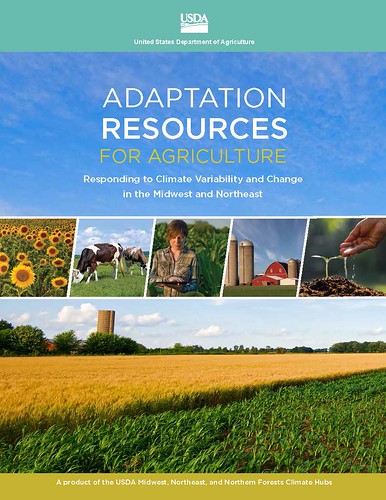
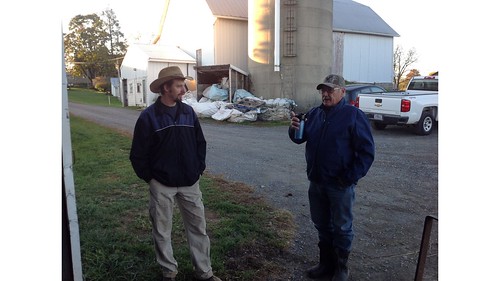
Posted by Dan Dostie, NRCS Project Liaison, USDA Northeast Climate Hub, on November 28, 2016 at 3:00 PM

USDA Adaptation Resources for Agriculture Workbook cover graphic
Changes in climate and more extreme weather are already increasing challenges for agriculture and natural resource managers nationally and globally. Many of these challenges are expected to continue into the future.
A new USDA report Adaptation Resources for Agriculture: Responding to Climate Variability and Change in the Midwest and Northeast provides educators and advisors information, perspective and resources to help farmers in the region prepare for, cope with and recover from the adverse impacts of a changing climate. Developed collaboratively by scientists, conservationists and educators, the report translates the best available climate science into usable resources for making climate-informed decisions.
Chapter One summarizes the effects of climate change on agriculture and natural resources in the Midwest and Northeast U.S. Chapter Two gives perspective on the concepts of climate adaptation in agriculture and the next three chapters provide new resources to put climate change information into action on the farm including adaptation strategies and approaches, an adaptation workbook, and examples for assessing and planning.
These new resources help extension educators, agricultural advisors and conservationists improve climate change education and adaptation assistance programs to help farmers sustain production, profitability and stewardship in the face of extreme weather and uncertain climate conditions.
Adaptation Strategies and Approaches provides a “menu” that brings together climate adaptation responses reported in peer-reviewed scientific literature and provides a clear rationale to connect planned actions to broad adaptation concepts. The Report also provides specific real-life adaptation tactics and actions—i.e., the how, where and when?—that can be applied on the ground. Adaptation tactics range from incremental adjustments of existing practices that help the production system address persistent climatic impacts to major alterations that transform the entire farm operation.
Flexible and adaptive management are key to reduce risk, increase resilience to potential disruptions, and even take advantage of opportunities presented by climate change. The Adaptation Workbook provides a structured process to consider potential climate change impacts, management challenges and opportunities, and climate adaptation responses.
Four examples of typical farming systems in the region: dryland farming in Nebraska, corn and soybean production in Iowa, small holder beef grazing and forestry in Missouri, and a confined dairy in Pennsylvania, give real-world perspectives on addressing challenges and opportunities of climate change.
Based upon the Forest Adaptation Resources developed by the U.S. Forest Service and Northern Institute of Applied Climate Science, Adaptation Resources for Agriculture was developed specifically to meet the unique needs of agricultural producers.
A team of authors from the Agriculture Research Service, the U.S. Forest Service and the Natural Resources Conservation Service worked together through USDA’s Climate Hubs for the Midwest, Northeast and Northern Forests to assemble the report. Educators, conservationists, and climate, agricultural and forestry scientists participated in workshops to test the concepts, translate them into easy to use worksheets, and develop the real-world examples.
You can download a pdf of the report at the National Climate Hubs website under the Adaptation Assistance menu.
For more on how USDA is helping farmers and land owners adapt to the effects of a changing climate see the related posts:
- New and Improved Tools Help Adapt Forests to Changing Conditions
- Adaptation Resources for Agriculture in the Midwest and Northeast

Dairy farmer Justin Geisinger works with trusted advisor NRCS Grazing Specialist Titus Martin on climate impact issues. This is accomplished working for USDA’s Natural Resources Conservation Service through the Agriculture Conservation Experienced Services (ACES) program. Photo by Dan Dostie, USDA, Natural Resources Conservation Service
Related Posts
Tuesday, November 29, 2016
Coral Reefs
From National Oceanic and Atmospheric Administration (NOAA):
Healthy coral reefs are one of the most diverse and valuable ecosystems on Earth. NOAA's Coral Reef Conservation Program works every day to make them more resilient to threats. http://go.usa.gov/x8RMv
Healthy coral reefs are one of the most diverse and valuable ecosystems on Earth. NOAA's Coral Reef Conservation Program works every day to make them more resilient to threats. http://go.usa.gov/x8RMv
Pileated Woodpecker
From U.S. Fish and Wildlife Service Midwest Region:
Pileated woodpecker pairs stick together and defend their territory all year. Calls, drumming and direct contact help keep intruding birds away.
Photo: Pileated woodpecker courtesy of David Mitchell/Creative Commons. https://flic.kr/p/NkDCRy
#bird
Pileated woodpecker pairs stick together and defend their territory all year. Calls, drumming and direct contact help keep intruding birds away.
Photo: Pileated woodpecker courtesy of David Mitchell/Creative Commons. https://flic.kr/p/NkDCRy
#bird
Water Frogs
From U.S. Fish and Wildlife Service Midwest Region:
Water frogs spend winters snoozing underwater. Unlike turtles that bury themselves completely, frogs prefer to sleep on top of the mud or only slightly buried.
Photo: Green frog by Katie Steiger-Meister/USFWS
Water frogs spend winters snoozing underwater. Unlike turtles that bury themselves completely, frogs prefer to sleep on top of the mud or only slightly buried.
Photo: Green frog by Katie Steiger-Meister/USFWS
USDA Helps Iraqi War Veteran Enhance Conservation On Farm
From the #USDA:
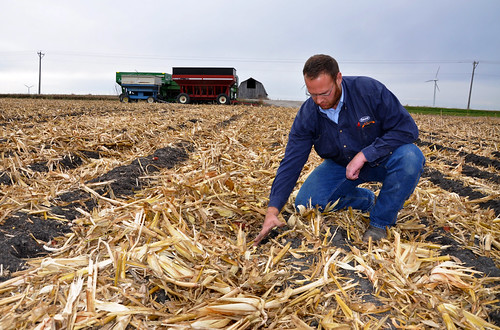
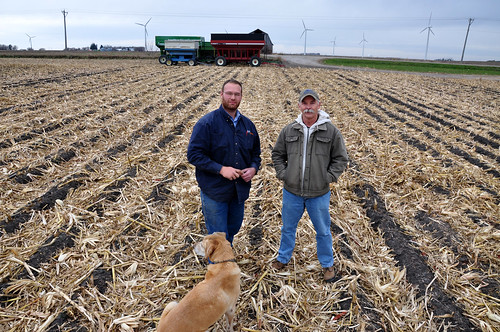
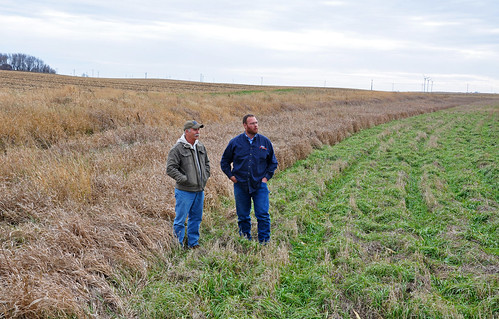

Posted by Jason Johnson, Public Affairs Specialist, USDA-Natural Resources Conservation Service, Des Moines, on November 14, 2016 at 3:30 PM

Adam Boge shows the height of the elevated ridges on his cropland and corn residue, key elements in his ridge till system to manage soil erosion and improve soil health.
The U.S. Department of Agriculture is helping Iraq War veteran Adam Boge improve technology and other efficiencies in his new farming operation, allowing the Ventura farmer to prepare for long-term success in the first full year on his own.
Boge enlisted in the Army directly out of high school. After his initial military service, he attended Iowa State University for Ag Systems Technology and Mechanical Engineering. College was interrupted, however, by his Iraq deployment. Boge represented the Army National Guard’s 1133rdTransportation Company out of Mason City for 15 months throughout 2003 and 2004 in Operation Iraqi Freedom.
Upon his return to the United States, he continued his education and also began taking “hired hand” positions on farms near Ames. “That’s when I started to think more seriously about developing a business plan to someday take over a farm,” he said. “Unless you’re born into it, though, it is really difficult to capture farming ground.”

NRCS District Conservationist Tony Moore, right, helped Cerro Gordo County farmer Adam Boge through the Conservation Stewardship Program (CSP) process. Boge is improving nutrient management efficiencies using new enhancement practices through CSP.
A Return to Iowa
Back in Iowa and still yearning to farm, Boge learned that his respected neighbor Dave Rosendahl could soon be retiring from farming. He quickly put together a proposal and approached Rosendahl about it. “That’s when things started to come together for me,” said Boge.
Back in Iowa and still yearning to farm, Boge learned that his respected neighbor Dave Rosendahl could soon be retiring from farming. He quickly put together a proposal and approached Rosendahl about it. “That’s when things started to come together for me,” said Boge.
While Rosendahl discussed the proposal with his family, Boge took an opportunity to learn more about Rosendahl’s management system. He helped a neighbor through the 2012 crop season, farming corn and soybeans in the Prairie Pothole region of Cerro Gordo County.
Prior to the 2013 planting season, Boge and Rosendahl formed a handshake agreement to crop share for three to five years, eventually handing over all day-to-day farming activities to Boge. However, that timeframe was quickly moved up. Boge said, “During the 2013 harvest Dave and I passed through the last bit of corn and Dave looked at me and said, ‘Here are the reigns. I’m complete. I’m satisfied.’”
Boge says his plan was to take over a couple hundred acres, but Rosendahl was ready to give up all 980 acres covering nine farms and five landlords.

Filter strips, like the one NRCS District Conservationist Tony Moore (left) and Ventura farmer Adam Boge are standing in, helped Boge become eligible for the Conservation Stewardship Program (CSP).
Conservation
As primary operator of the ground, Boge was eligible to apply for local, state and federal conservation programs. Coincidentally, the 2014 Farm Bill provides benefits for veterans like Boge who are beginning farmers.
As primary operator of the ground, Boge was eligible to apply for local, state and federal conservation programs. Coincidentally, the 2014 Farm Bill provides benefits for veterans like Boge who are beginning farmers.
Boge visited the USDA Service Center in Mason City and spoke with Tony Moore, district conservationist with USDA’s Natural Resources Conservation Service (NRCS), about conservation planning and programs for his new operation. Moore recommended Boge apply for the Conservation Stewardship Program (CSP).
When beginning veteran farmers apply and receive eligibility for CSP, they are given priority status by NRCS to receive funding. Boge became CSP eligible on all 980 acres.
He credits Rosendahl for his CSP eligibility, considering Rosendahl implemented many conservation practices on the land throughout the years, including filter strips along drainage ways, natural wetlands for wildlife habitat, and years of soil saving with ridge till.
“I want to continue what Dave was doing,” said Boge. “The way Dave farmed and took care of his land, I see no reason to change it. There is ground here that hasn’t been ripped in 30 years. There is an unbelievable amount of soil tilth out there created by earthworm activity.”
Moving forward, Boge is implementing an enhancement bundle he chose through CSP, which include widening stream buffers, and improving nutrient and pesticide application techniques. “A lot of it is updating the technology and making the operation more efficient,” he said. “Updated GPS will ensure I don’t over-apply nutrients and pesticides. CSP is allowing me to take the operation to another level.”

– Following the 2014 soybean harvest, Boge knifes nutrients directly into raised ridges that are the signature of his farmland.
Boge says he’s appreciative of USDA support for veterans trying to get a start in agriculture. “You spend time in a combat environment and come back, you think there isn’t much you shouldn’t be able to achieve, but you hit roadblocks and it gets discouraging after a while,” he said. “As veterans, we don’t ask for much from our country. I wanted to achieve everything on my own, but when you sit down and look at the bottom dollar, maybe I needed a little help. If CSP is the way to get it, then that’s OK.”
For more information about conservation plans and programs, visit your local USDA Service Center, or go online to www.nrcs.usda.gov.
Download a printed copy of this story, here.
Related Posts
Mountain Bluebird
From U.S. Fish and Wildlife Service, Mountain-Prairie Region:
This mountain bluebird rides the storm out. Stay warm friends! Photo: Tom Koerner/USFWS
This mountain bluebird rides the storm out. Stay warm friends! Photo: Tom Koerner/USFWS
Monday, November 28, 2016
The Convict Tang
From USFWS National Wildlife Refuge System:
The convict tang has the Hawaiian name “manini”. It’s a member of the surgeonfish family, named for the sharp blades on either side of its tail. The fish is just one of the tremendous natural resources protected by Papahānaumokuākea Marine National Monument in the Pacific.(https://www.fws.gov/
The convict tang has the Hawaiian name “manini”. It’s a member of the surgeonfish family, named for the sharp blades on either side of its tail. The fish is just one of the tremendous natural resources protected by Papahānaumokuākea Marine National Monument in the Pacific.(https://www.fws.gov/
Sunday, November 27, 2016
Tiger Swallowtail
From U.S. Fish and Wildlife Service Midwest Region:
A warm fall can mean interesting wildlife sightings! We spotted this tiger swallowtail earlier this month. What have you seen?
Photo: Tiger swallowtail by Mara Koenig/USFWS.
A warm fall can mean interesting wildlife sightings! We spotted this tiger swallowtail earlier this month. What have you seen?
Photo: Tiger swallowtail by Mara Koenig/USFWS.
USDA Blog » Conservation as a Peace Offering to Vietnam War Veteran
Conservation is giving Vietnam War veteran Gilbert Harrison a peace offering of healing, helping to balance the stresses of war. For Harrison, conserving the natural resources on his farm is an important outdoor activity. And who better to care for the land than the veterans who fought to protect it?
USDA Blog » Conservation as a Peace Offering to Vietnam War Veteran
USDA Blog » Conservation as a Peace Offering to Vietnam War Veteran
Saturday, November 26, 2016
Ruby-throated Hummingbird
From U.S. Fish and Wildlife Service Midwest Region:
This ruby-throated hummingbird was recently spotted in Ohio. Leaving your feeders out won’t delay migration and can help provide essential food to stragglers!
Photo: Ruby-throated hummingbird courtesy of Brian Wulker/Creative Commons. https://flic.kr/p/NVfZUd
This ruby-throated hummingbird was recently spotted in Ohio. Leaving your feeders out won’t delay migration and can help provide essential food to stragglers!
Photo: Ruby-throated hummingbird courtesy of Brian Wulker/Creative Commons. https://flic.kr/p/NVfZUd
Kingman Reef National Wildlife Refuge
From USFWS National Wildlife Refuge System:
As winter and its chill approach on the mainland, let’s imagine ourselves in south Pacific snorkeling near this pencil urchin at Kingman Reef National Wildlife Refuge (http://bit.ly/2dYB7Cr). Kingman Reef is less than 5 feet in elevation and has no permanent land. Still two small emergent coral rubble spits make it one of the most pristine coral reef atoll ecosystems in the Pacific Ocean. Photo by Amanda Pollock/U.S. Fish and Wildlife Service
As winter and its chill approach on the mainland, let’s imagine ourselves in south Pacific snorkeling near this pencil urchin at Kingman Reef National Wildlife Refuge (http://bit.ly/2dYB7Cr). Kingman Reef is less than 5 feet in elevation and has no permanent land. Still two small emergent coral rubble spits make it one of the most pristine coral reef atoll ecosystems in the Pacific Ocean. Photo by Amanda Pollock/U.S. Fish and Wildlife Service
Friday, November 25, 2016
Red-bellied Woodpecker
From U.S. Fish and Wildlife Service Midwest Region:
It’s not always easy to see how the red-bellied woodpecker got it’s name. Here’s a great visual!
Photo: Red-bellied woodpecker courtesy of Ron Amundson/Creative Commons.https://flic.kr/p/PiKmFk
#Bird
It’s not always easy to see how the red-bellied woodpecker got it’s name. Here’s a great visual!
Photo: Red-bellied woodpecker courtesy of Ron Amundson/Creative Commons.https://flic.kr/p/PiKmFk
#Bird
Wishing everyone a wild and wonderful Thanksgiving!
From U.S. Fish and Wildlife Service:
Wishing everyone a wild and wonderful Thanksgiving!
This wild turkey shows its wattle and caruncles. The wattle is a skin flap that goes from the beak to the neck. Caruncles are bumps of flesh that cover the birds’ necks and heads. More facts to impress the flock: http://bit.ly/2gKXDTd
Photo: Matt Poole / USFWS
Wishing everyone a wild and wonderful Thanksgiving!
This wild turkey shows its wattle and caruncles. The wattle is a skin flap that goes from the beak to the neck. Caruncles are bumps of flesh that cover the birds’ necks and heads. More facts to impress the flock: http://bit.ly/2gKXDTd
Photo: Matt Poole / USFWS
Red-border Pixie Butterfly
From USFWS National Wildlife Refuge System:
A red-border pixie butterfly alights at Santa Ana National Wildlife Refuge. The south Texas refuge is best known as birders’ paradise: http://bit.ly/2fzjskc. Photo by Cristina De La Garza/U.S. Fish and Wildlife Service
A red-border pixie butterfly alights at Santa Ana National Wildlife Refuge. The south Texas refuge is best known as birders’ paradise: http://bit.ly/2fzjskc. Photo by Cristina De La Garza/U.S. Fish and Wildlife Service
Thursday, November 24, 2016
Wild Turkeys
From Bureau of Reclamation:
Wild turkeys were re-introduced into the area surrounding Lake Roosevelt National Recreation Area and are doing very well. Some have even moved into town. Photo by Craig Brougher, Hydrologic Technician with the Bureau of Reclamation, Grand Coulee Power Office.#HappyThanksgiving #wildturkeys#GrandCouleeDam
Wild turkeys were re-introduced into the area surrounding Lake Roosevelt National Recreation Area and are doing very well. Some have even moved into town. Photo by Craig Brougher, Hydrologic Technician with the Bureau of Reclamation, Grand Coulee Power Office.#HappyThanksgiving #wildturkeys#GrandCouleeDam
Wednesday, November 23, 2016
Small herd of Bighorn Sheep
From Bureau of Reclamation:
Small herd of Bighorn Sheep found within the Lake Roosevelt National Recreation Area. This group lives on and near Whitestone Rock,WA. Photo by Craig Brougher, Hydrologic Technician with the Bureau of Reclamation, Grand Coulee Power Office. #wildlifewednesday
Small herd of Bighorn Sheep found within the Lake Roosevelt National Recreation Area. This group lives on and near Whitestone Rock,WA. Photo by Craig Brougher, Hydrologic Technician with the Bureau of Reclamation, Grand Coulee Power Office. #wildlifewednesday
Mountain Lion
From U.S. Department of the Interior:
Partly within the Los Angeles city limits, Santa Monica Mountains National Recreation Area in California is home to a small population of mountain lions. National Park Service researchers have monitored more than 50 mountain lions in the park since 2002. Roaming freely, these big cats face unique challenges living so closely to urban areas. Photo by National Park Service. — at Santa Monica Mountains National Recreation Area.
Partly within the Los Angeles city limits, Santa Monica Mountains National Recreation Area in California is home to a small population of mountain lions. National Park Service researchers have monitored more than 50 mountain lions in the park since 2002. Roaming freely, these big cats face unique challenges living so closely to urban areas. Photo by National Park Service. — at Santa Monica Mountains National Recreation Area.
Tuesday, November 22, 2016
Sea Lion Pup
From National Oceanic and Atmospheric Administration (NOAA):
Worried about putting on extra weight over the holidays? These California sea lion pups sure aren't! After three years of underweight pups stranding in high numbers on Southern California beaches, scientists from @NOAAFisheries report that this year things are looking up for pups. Their average weight has increased and the pups are better nourished in 2016 according to recent research from scientists studying sea lion colonies on the Channel Islands. http://go.usa.gov/x8Xk3
Worried about putting on extra weight over the holidays? These California sea lion pups sure aren't! After three years of underweight pups stranding in high numbers on Southern California beaches, scientists from @NOAAFisheries report that this year things are looking up for pups. Their average weight has increased and the pups are better nourished in 2016 according to recent research from scientists studying sea lion colonies on the Channel Islands. http://go.usa.gov/x8Xk3
Monday, November 21, 2016
Protecting Land Near Yellowstone National Park
From U.S. Department of the Interior:
Today, Interior and U.S. Department of Agriculture took steps to protect land near Yellowstone National Park from the threat of mining. New mining claims will be prohibited on 30,000 acres of public lands, helping to ensure that Yellowstone’s watershed, wildlife and outdoor recreation are not threatened by the impacts of mineral development. Learn more: http://on.doi.gov/2fyfEiG — at Yellowstone National Park.
Today, Interior and U.S. Department of Agriculture took steps to protect land near Yellowstone National Park from the threat of mining. New mining claims will be prohibited on 30,000 acres of public lands, helping to ensure that Yellowstone’s watershed, wildlife and outdoor recreation are not threatened by the impacts of mineral development. Learn more: http://on.doi.gov/2fyfEiG — at Yellowstone National Park.
Wednesday, November 16, 2016
Dale Bumpers White River National Wildlife Refuge
From U.S. Department of the Interior:
A vital wetland in the Mississippi River watershed, Dale Bumpers White River National Wildlife Refuge in Arkansas is a haven for a variety of native wildlife and migratory birds. Its fertile forests and some three hundred lakes are interlaced with streams, swamps and bayous. The refuge also shows off some pretty fall colors. Photo by Rita Szabo (www.sharetheexperience.org).
A vital wetland in the Mississippi River watershed, Dale Bumpers White River National Wildlife Refuge in Arkansas is a haven for a variety of native wildlife and migratory birds. Its fertile forests and some three hundred lakes are interlaced with streams, swamps and bayous. The refuge also shows off some pretty fall colors. Photo by Rita Szabo (www.sharetheexperience.org).
Sunday, November 13, 2016
Cedar Waxwing
From U.S. Fish and Wildlife Service Midwest Region:
Now is a great time to see large flocks of cedar waxwings foraging for berries and other wild fruit.
Photo: Cedar waxwing courtesy of Steve Gifford. https://flic.kr/p/Np4L63
Now is a great time to see large flocks of cedar waxwings foraging for berries and other wild fruit.
Photo: Cedar waxwing courtesy of Steve Gifford. https://flic.kr/p/Np4L63
Saturday, November 12, 2016
Growth and Opportunity in the Organic Sector
From the #USDA:
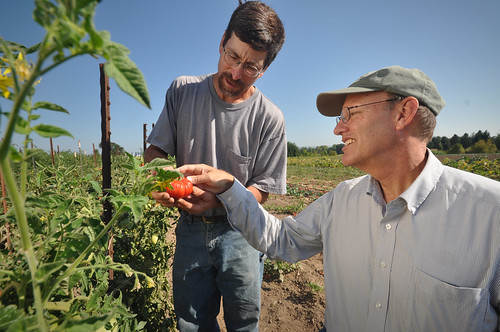
Posted by Elanor Starmer, Agricultural Marketing Service Administrator, on November 10, 2016 at 11:00 AM

Chris Roehm (left), an organic farmer from Square Peg Farms in Oregon, examines tomatoes with USDA resource conservationist Dean Moberg. Since the USDA implemented the organic regulations, the U.S. organic sector has tripled in size to over 22,000 certified organic operations with over $43 billion in U.S. retail sales. Photo by Ron Nichols.
Since USDA’s Agricultural Marketing Service (AMS) implemented the organic regulations in 2002, the U.S. organic sector has tripled in size to over 22,000 certified organic operations with over $43 billion in U.S. retail sales. Demand for organic products is expected to continue growing. This strong consumer demand outruns supply, providing market opportunities within the organic sector.
USDA offers many resources for organic producers and businesses – including organic certification cost share assistance, organic price reporting, conservation programs, and so much more – to facilitate growth within the organic sector. We also provide assistance to producers transitioning to organic production, and work to facilitate international trade.
To learn more about our services, you can now visit the redesigned USDA organic portal. The new site features a more user-friendly design with updated content that allows you to access the USDA resources for the organic community from one centralized location.
During this Administration, we strengthened the USDA Organic Working Group – an internal information-sharing group who come together to coordinate USDA programs and services that support the organic sector – and successfully worked across agencies to expand our organic services. Additionally, Secretary Vilsack issued guidance to all USDA agencies affirming the department-wide commitment to the organic sector. Our collaborative efforts have set the groundwork for continued growth by connecting farmers and businesses to training, strengthening the National Organic Program, funding organic research, and improving crop insurance options for organic producers. Here are just a few examples.
Our Sound & Sensible initiative is simplifying and streamlining the organic certification process, and providing tools and resources to the entire organic community. The Risk Management Agency (RMA)provides improved insurance options for organic producers, including organic premium price elections for 57 crops, and a transitional crop insurance option, offering insurance that better reflects the product’s market value.
Since 2009, the Natural Resource Conservation Service (NRCS) has worked with more than 6,800 organic farms and provided more than $115 million in assistance through its EQIP Organic Initiative. The Farm Service Agency (FSA) continues to act as a bridge to all USDA opportunities, and recently set a goal of enrolling 20,000 organic acres in conservation buffers through the Conservation Reserve Program. Earlier this month, the National Agricultural Statistics Service (NASS) published results from its fourth organic producer survey, showing a significant increase in organic farm receipts and reflecting updated data on prices, farming practices, and conservation practices.
Demand for organic products is not limited to the U.S. domestic market. The global organic market includes over 31,000 certified operations and is valued at nearly $80 billion annually. Organic trade continues to expand to meet the demands of the organic market. AMS works closely with countries around the world to support this growing market. We maintain organic equivalency arrangementswith Canada, Japan, Korea, Switzerland and the European Union. These arrangements simplify the process for all farms and businesses to participate in the global organic market to ensure the integrity of imported organic products.
We are committed to establishing a level playing field that protects all organic farms and businesses through clear and transparent standards while maintaining the integrity of the USDA organic seal for consumers. Earlier this year, we published a proposed rule clarifying requirements for livestock and poultry living conditions and health care practices. We are working on a final rule based off feedback from the organic community.
Organic continues to be a bright spot in the agricultural economy, and USDA strongly supports organic agriculture. We look forward to working together with the organic community.
Related Posts
Tags: AMS, business development, Conservation Reserve Program, EQIP Organic Initiative, Farmers, FSA, KYF2, Local and Regional Foods, local food, NASS, National Organic Program, NOP, NRCS, organic, Organic 101, organic certification, Pricing, Producers, Ranchers, RMA, sound and sensible, Tom Vilsack, USDA Market News
Subscribe to:
Comments (Atom)



















